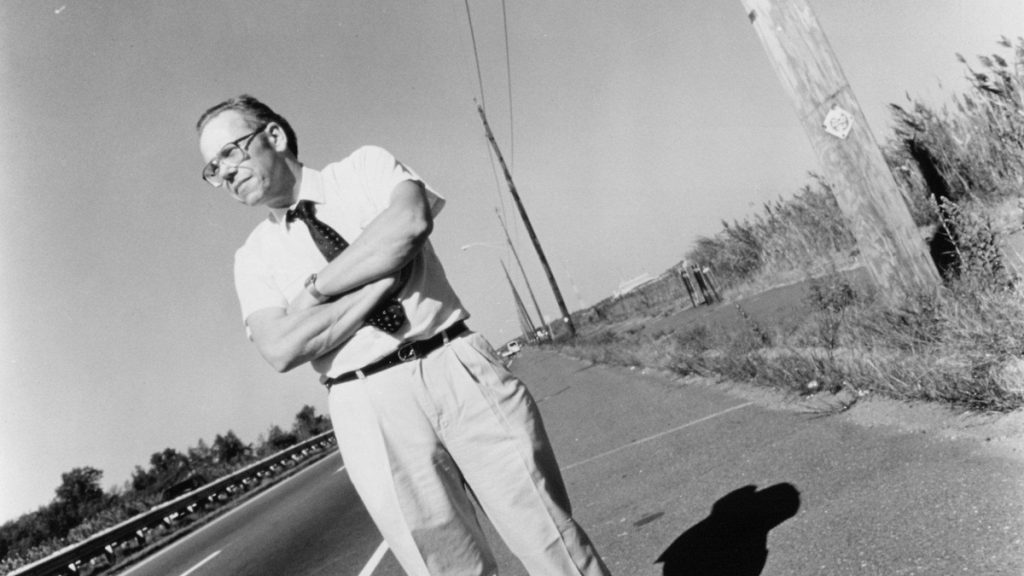The horrors you see in documentary films tend to be infuriating or harrowing. They inform you of terrible things about the world, but they are not exactly fun. Errol Morris’s Mr. Death: The Rise and Fall of Fred A. Leuchter, Jr. is a kind of documentary horror film that gives some good little chills. But it also induces a more profound terror by exploring how odd, flawed people can blunder their way into–well, if not evil itself, then aiding and abetting it.
Morris first presents his subject as a schlubby but terrifying little ghoul. Leuchter’s geeky glasses and thick Boston accent belie his macabre mission and worldview. Like a Dr. Frankenstein in reverse, the engineer wants not to create life, but to craft perfect death. In businesslike talking head interviews, he details the tweaks he has made to electric chairs, gas chambers, and lethal injection machines, and frankly details the dangers and indignities his improvements have allegedly avoided. (Electrocution can apparently make human flesh like “the meat coming off a cooked chicken,” or make the convict “quite frankly, piss on the floor.”) He does his grisly work with total moral certainty: a proponent of the death penalty, he nevertheless believes in making executions as humane as possible.
Morris has always been fascinated with the weird and the morbid, and he leans into this by playfully portraying Leuchter as a mad scientist. In a cinematic tableau in the opening credits, he places his subject in a metal cage. It’s the command center of an enormous laboratory, with bolts of electricity flashing all around. When Leuchter takes us on tours of his death chambers, slow-motion, black-and-white footage, and canted angles make his incongruous grins look maniacal. Morris also includes clips of Thomas Edison’s infamous film Electrocuting an Elephant, linking Leuchter to the inventor who performed a lethal experiment on a beast to test and promote his new cinematic technology.
Morris (particularly in films like Thin Blue Line and Standard Operating Procedure) loves an investigation, even an insane one. The meat of Mr. Death is a cautionary tale about doing your “own research,” as Leucter’s alleged “expertise” leads him into full-blown Holocaust denial. When called to testify for the defense of “revisionist historian” Ernst Zündel (on trial in Canada for spreading hate speech), Leuchter glibly enters Auschwitz with a chisel and a hard hat, and concludes that the Nazi gas chambers never existed. Like Dr. Frankenstein, he’s an unrepentant grave robber, chipping away at these sacred sites to procure samples that prove nothing. Footage taken by a videographer shows Leuchter as rather proud of himself, and a little thrilled that he’s where he shouldn’t be and might get caught. Morris edits this footage with chiaroscuro shots of shadowy men lurking around corners. Stylized close-ups show hands dramatically performing Leuchter’s meaningless measurements. Everything has the air of a creepy fantasy, all the more terrifying because it’s such obvious fiction.
For morality’s sake, this nonsense must be cut down with a quickness. Mr. Death does this thoroughly, with a counter-investigation conducted by Robert Jan van Pelt. An architect and historian of the Holocaust, van Pelt is the genuine expert and the film’s voice of reason. Where Leuchter’s “investigation” rests on the derring-do of his swaggering excavations, van Pelt does the less glamorous work of diving into the archives. He reveals documents (architectural plans and telegraphs placing orders for gas) that spell out an irrefutable truth.
One of Morris’s great skills is his ability to cut and weave shots of text and documents together to make them both rhetorically convincing and visually compelling. (Here, where all the text is in German, the feat is even more impressive.) Close-ups of the relevant documents, tied together by van Pelt’s narration, shut down any possible “revisionism.” Van Pelt treats the archive of this history with humility and reverence, and there are lovely close-ups of his hands untying the ribbons of files. They do more than words could to affirm the power of the real work of history.
For all the fun Morris has playing with horror movie tropes, Mr. Death has greater depth because he does not believe in monstrosity. Leuchter is all too human, and his story ends as his feet of clay dissolve. When Leuchter’s views are made public, he becomes too toxic even for work on death machines. As he tells of his woes (not only lost jobs, but lost apartments and a divorce that seems like it was a long time coming), Morris makes him into even more of a sad sack; bleak black-and-white reenactments show Leuchter standing on the side of a deserted highway after his car is impounded.
Because he’s a student of the weirdnesses and vagaries of human existence, Morris lingers on the strange twists of fate that brought about Leuchter’s disgrace. Had Zündel not come knocking on Leuchter’s door, would he ever even dreamed up the idiocies that ruined him? Morris tends to reserve judgment and look at a person’s character from many angles. But just because he looks like a schmuck doesn’t mean that Leuchter isn’t guilty of the most profound and stubborn hubris.
If his moments of generosity toward Leuchter are troubling, the discomfort works because Morris is at the height of his powers. He can make a coherent and fervent case against appalling falsehood while also fleshing out the odd circumstances and quirks of character that could unexpectedly lead someone down such a bizarre and awful path. Morris may have slantwise ways of looking at the world, but it doesn’t stop him from pinning down the awful truth.
“Mr. Death” is streaming on AMC+.

